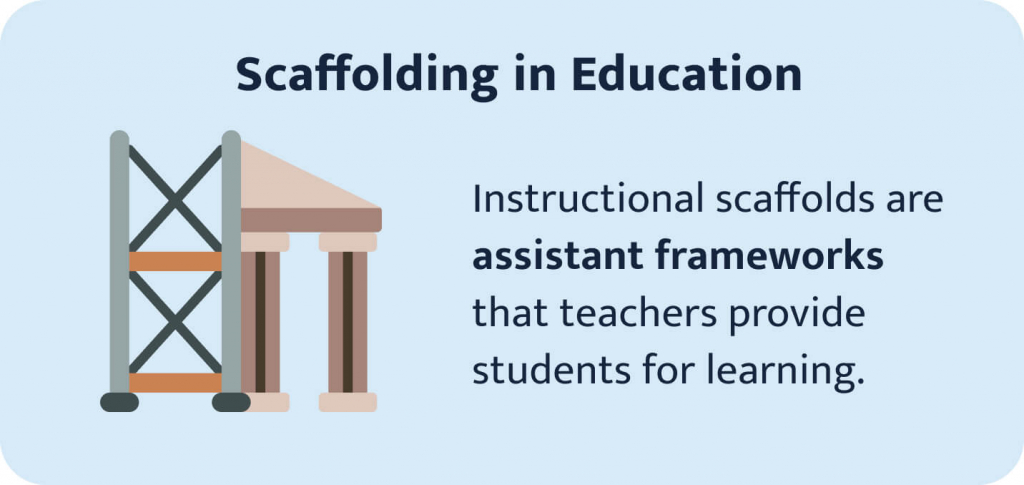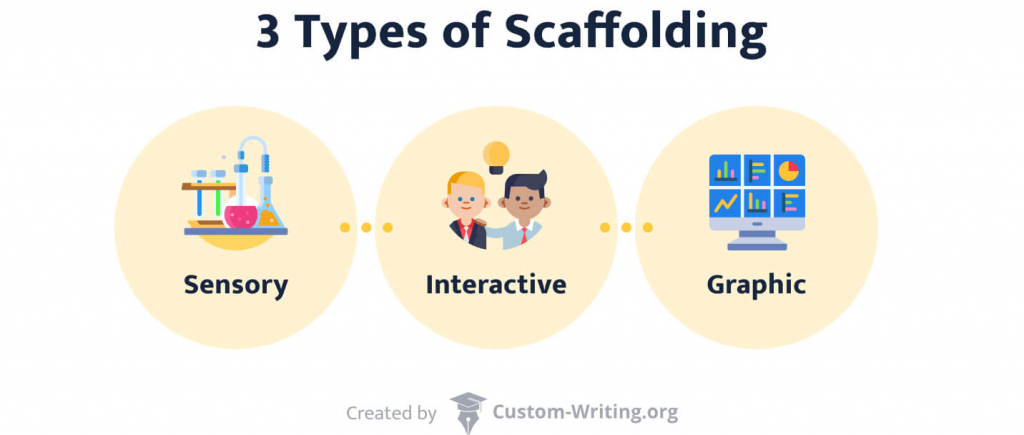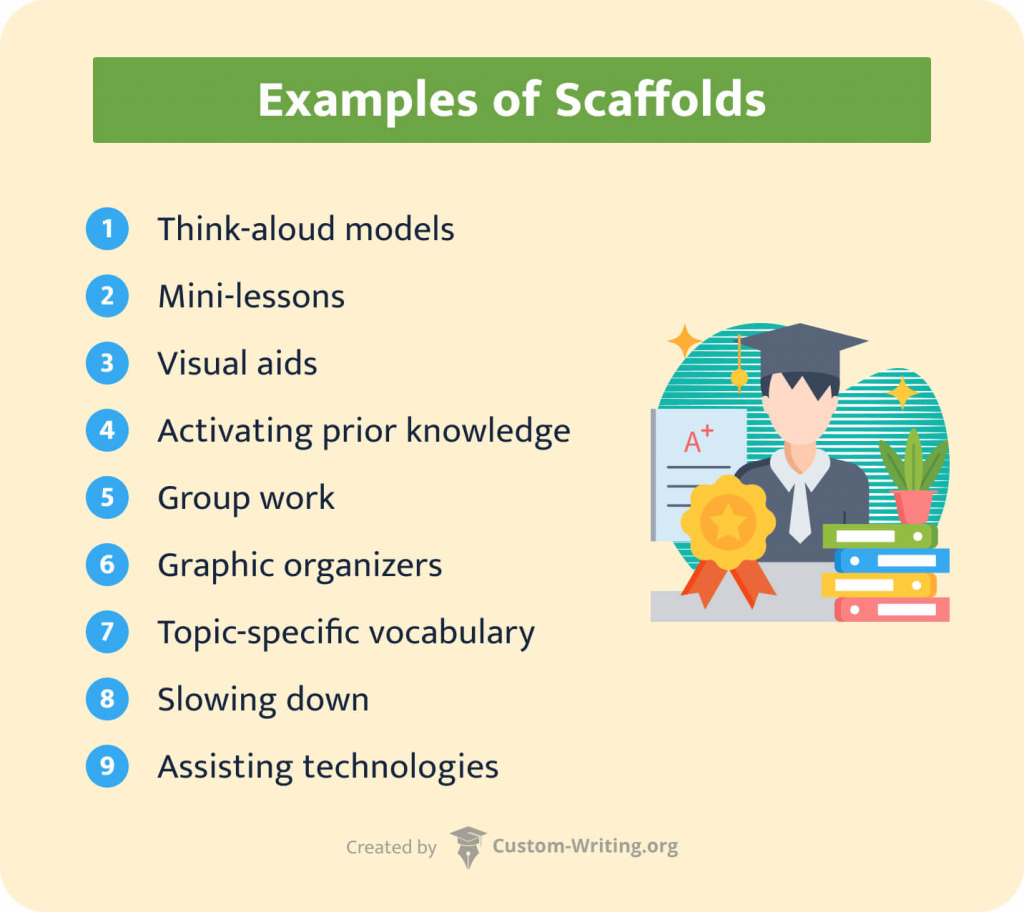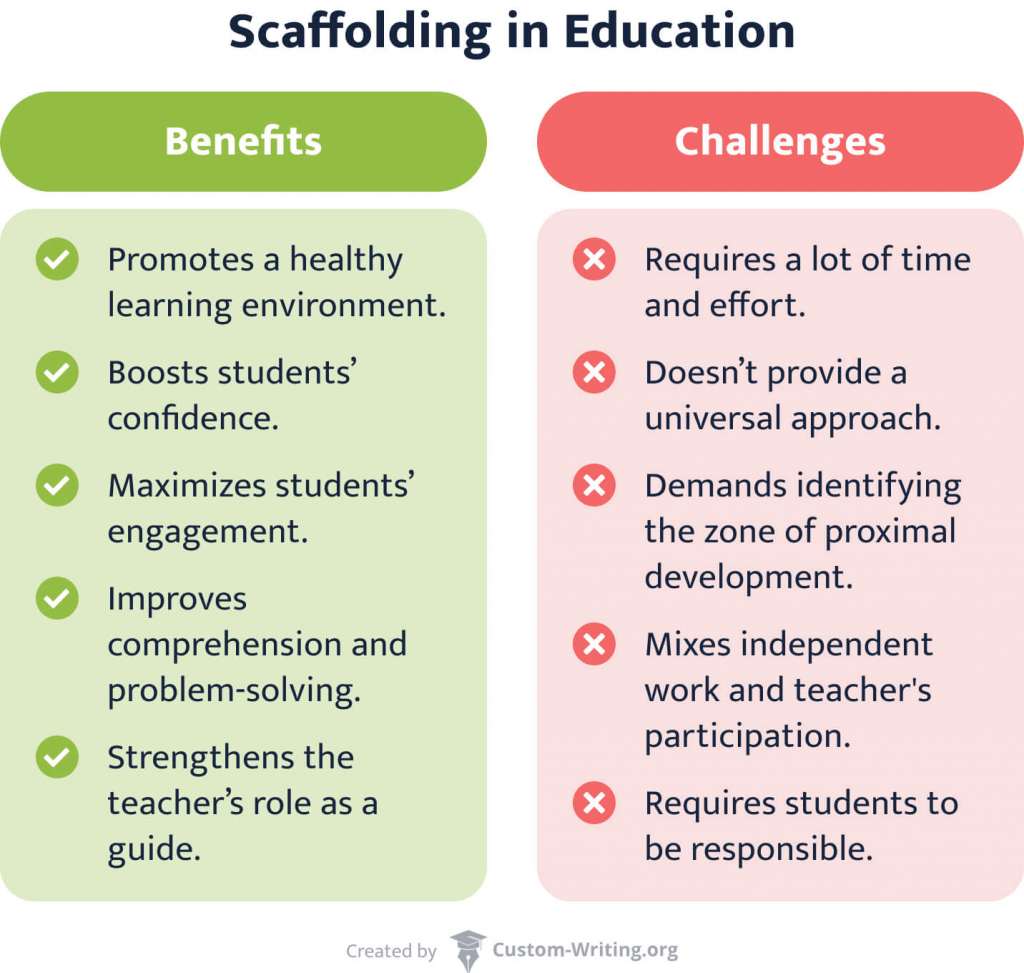The role of a teacher in education has changed drastically with the popularization of online courses, study apps, YouTube videos, and other free tools. Some people mistakenly think they don’t need guidance since there are so many opportunities for self-study. The others are sure that individual professional support is essential for efficiently acquiring knowledge. A teacher is the one who helps students bridge the gap between what they need to know and how to get that knowledge, and this input benefits academic performance more than any other factor.

Among numerous teaching techniques, we recommend paying attention to scaffolding. As in construction sites, scaffolding in education means providing support for students while they are doing their work – studying. This article will cover the key benefits of scaffolding and provide ideas on how to incorporate it into the classroom. Check our free knowledge base at Custom-writing.org for more study tips!
🗣️ What Are Scaffolds in Teaching?
Imagine a work crew repairing a building at great heights. Without the use of scaffolding, their work would be more dangerous and less productive. The same principle applies to scaffolding in education. The role of a teacher is to facilitate students with all the necessary tools and information to get the most out of their studies.
Scaffolding in Education
In the educational context, the term “scaffolding” was first used by the American psychologist Jerome Bruner in the 1960s. According to his theory, when students have enough support while learning a new subject, they become more adept at using this knowledge independently later.
Modern educators explain scaffolding as a teaching technique in which instructors strengthen students’ understanding by giving them an assistant framework for learning. Once students reach the intended level of mastery, the teachers gradually remove their support.
An excellent example of scaffolding in the classroom is modeling. Many students are visual learners and prefer seeing something to hearing about it. Imagine a teacher assigns a task to conduct a SWOT analysis of a company. Scaffolding, in this case, is providing a SWOT template on top of basic instructions on how to run a SWOT analysis. This way, a teacher eases the stress and makes the task more manageable by showing students what they are expected to do.
Principles of Scaffolding in Teaching
The main principles of scaffolding include the following:
- Attracting students’ attention. To make students ready to follow the instructions on the task, a teacher should spark their interest and imagination first.
- Simplifying the task. By reducing the number of actions necessary to solve a task, a teacher allows the student to focus on the main ideas.
- Keeping attention on the goal. Since many students get distracted easily, the teacher should keep the lesson’s purpose in mind and maintain students’ motivation.
- Emphasizing important details. The teacher should draw students’ attention to the significant details of the task to help them achieve the best results possible.
- Demonstrating an idealized version of the task. The teacher must show the modeling answer or result, so the students understand what is expected.

Types of Scaffolding Supports
Educators differentiate three types of scaffolding techniques: sensory, interactive, and graphic. Learn everything about the three core kinds of scaffolding and how they’re best applied.
- Sensory scaffolding.
Sensory scaffolding allows students to use their senses to understand abstract ideas and complex topics. By combining physical objects with oral explanations, a teacher makes instructions more comprehensible and enhances students’ long-term memory. Examples of sensory scaffolding techniques include using real-life objects, models, figures, videos, and pictures and participating in physical activities. - Interactive scaffolding.
Many human beings are social learners, meaning they enjoy discussing ideas, offering observations, and forming opinions. Interactive scaffolding integrates social exchange into the classroom and helps students learn from collaboration. It can exist in the form of interviews, group or pair work, conferences, and class discussions. - Graphic scaffolding.
Graphic scaffolding is particularly helpful when a teacher wants to communicate highly abstract concepts or show the relationships between two or more phenomena. The knowledge presented through visual aids will likely serve students long after they’ve left the classroom. The most common graphic scaffolding instruments are charts, tables, graphs, timelines, and infographics.
Benefits of Instructional Scaffolding
Scaffolding can be a lot of work. However, this method offers many benefits to students and teachers. Let’s run through some of the most impressive advantages of scaffolding.
📌 It improves students’ understanding. Scaffolding allows students to achieve skill mastery faster by breaking down complex tasks into easier steps. It also clarifies the teacher’s instructions, creating a comfortable environment for students’ development.
📌 It boosts students’ productivity. Active teacher engagement helps students focus on a task longer and avoid distractions. Moreover, scaffolding techniques prevent students from giving up on difficult things and zoning out.
📌 It’s engaging. Scaffolding makes students feel included and supported during the learning process. Thus, they gain confidence to work on more complicated tasks without getting frustrated or bored.
📌 It gives a teacher valuable insight. The scaffolding process requires a teacher to observe students and their needs carefully. Monitoring the learning process can provide many insights into each student’s abilities and the types of materials used in the classroom.
📌 It encourages independent learning. Once the student performs at a certain level of mastery, the teacher can gradually remove the scaffolding support. In this way, a teacher can help students build effective independent learning skills essential to success in adult life.
📌 It empowers collaborative skills. Scaffolding is all about collaborating with a teacher in pairs and groups. Working together with their classmates, students have a unique opportunity to improve their leadership, active listening, and problem-solving skills.

📝 Scaffolding Lesson Plan Template
If you wonder how scaffolding can be implemented in a classroom, check out the section below. We created this lesson plan template, which demonstrates the use of the technique at every stage. However, notice that this is not a universal scheme. In fact, lesson plans will vary according to a particular scaffolding technique.
Part I. Before the lesson
- Determine the students’ current level of knowledge to see how much support they will need. An excellent method is to develop a small questionnaire and ask students to fill it in beforehand.
- Identify the possible difficulties. When planning a lesson, consider what steps might be challenging for students. The more complex the task is, the more support they will need.
- Think of ways to personalize the content. Keep in mind the students’ interests and preferences to help keep them engaged. Prepare some exercises to allow them to share their opinions and feel excited about the new content.
Part II. During the lesson
- Encourage students to brainstorm on a new topic. This process will help them reactivate background knowledge and build up the connection with new information.
- Carefully observe the students’ individual and group work. Take notes on what scaffolding techniques work best for them and what could be changed.
- Provide constructive feedback. Sometimes you might need to clear up the students’ misconceptions or incorrect responses. Ensure it doesn’t hurt their feelings but helps secure the new knowledge.
Part III. After the lesson
- Support students’ independent learning. If they have successfully understood the new material, offer them homework.
- Reflect on the scaffolding techniques that you used. Think of strategies that proved to be the most effective in the classroom and how to incorporate them into other lessons.
- Ask students for feedback. Come up with a questionnaire to see what students liked the most about the lesson and what parts were the most challenging.
🚀 Scaffolding Strategies: TOP 10 Examples
Check out these top ideas if you’re looking for original examples of scaffolding in the classroom.
Strategy 1 – Activate students’ prior knowledge
Scaffolding can only be effective when it is clear what students already know. This information can be collected directly from students, their past teachers, or previous units. Activating students’ prior knowledge will help build a solid foundation for the rest of the lesson.
Strategy 2 – Brainstorm and think out loud
To keep students engaged, try to explain in easy-to-understand terms what they’re doing and why. It might be mind maps, flow charts, or real-life objects that demonstrate a teacher’s thought process. These verbal and nonverbal cues will definitely improve students’ understanding.
Strategy 3 – Repeat as much as needed
The idea that practice makes perfect lies at the foundation of scaffolding. When introducing a concept or a skill in the lesson, it’s essential to reinforce the new knowledge. To reduce teacher-talking time, try these practicing techniques: turn and talk (students discuss the topic in pairs), small group discussions, or the pause method (asking students open-ended questions).
Strategy 4 – Encourage active participation
Remember to encourage class participation and provide positive reinforcement for students’ answers. Make corrections when needed or let students provide feedback on each other’s ideas. These collaborative learning strategies will help strengthen students’ social skills and understanding of the topic.
Strategy 5 – Maintain the pause
Instead of providing students with the answer immediately after asking a question, leave a pause. The silence might feel uncomfortable during the wait time, but students will eventually start to brainstorm some solutions. This method also guarantees students’ equal participation by creating a safe environment for sharing ideas and opinions.
Strategy 6 – Encourage independent learning
Students who demonstrate a solid understanding of the lesson might need less support. To help students work independently and master their skills, the “I do, we do, you do” method might be helpful. Start the class with clear instructions (I do), then organize work in small groups (we do), and finally, when students are comfortable with the new concept, they can practice on their own (you do).
Strategy 7 – Use visual aids
Pictures, graphs, and charts are among the most effective scaffolding tools. These visual aids help students organize new information, grasp abstract concepts, and remember the material in the next lesson. Visuals can significantly improve students’ performance during everyday tasks like group discussions, writing essays, or working with handouts.
Strategy 8 – Break complex tasks into smaller steps
Often, it’s challenging for students to remember all the steps needed to complete an assignment. To ease the pressure, break down instructions into chunks that students will follow one at a time. Another idea is to offer students a checklist they can use during individual work or group projects.
Strategy 9 – Teach students to help each other
One of the best scaffolding techniques when working with students with mixed abilities is empowering them to help each other. For example, ask a strong student to answer a question when learning a new concept. Then, you can call on another student to repeat the answer in their own words. By listening to each other, students of all levels reinforce their understanding.
Strategy 10 – State clear expectations
In general, human beings are better at performing tasks when they fully understand what is expected from them. Thus, providing model answers and describing the purpose of the assignment is crucial. Always provide clear directions or use rubrics and checklists to help students successfully master the concept.

🧨 Challenges of Educational Scaffolding
Scaffolding has proved to be a beneficial instructional technique that can be used in various classrooms. However, teachers may face particular challenges when incorporating scaffolding into their lessons. Consider the most common ones:
- Planning lessons that will include scaffolding methods can be time-consuming.
- Not all scaffolding techniques are equally beneficial for all students.
- If the teacher provides too much support, it might negatively influence students’ autonomy.
- The effectiveness of scaffolding methods depends on how well a teacher knows their students.
- Students who haven’t experienced the scaffolding teaching method might need extra time to adapt.
- There’s a lack of information available on scaffolding tips and practical advice.
🔝 Other Effective Teaching Methods
You might be surprised to learn how many teaching strategies there are besides scaffolding. More and more teachers are implementing new instructional methods to find the best match for their students’ learning styles. Let’s cover some of the most popular and beneficial teaching strategies for you to try!
- Use of educational technologies.
Many students feel excited about technology-based lessons, especially when technology is integrated uniquely. This teaching strategy creates a more engaging learning environment and prepares students for the future. However, it’s essential to carefully balance electronic devices with real-life communication in the classroom. - Inquiry-based learning.
This modern educational approach engages students by making real-world associations through exploration and high-level questioning. Instead of presenting new content immediately, the teacher triggers students’ curiosity and allows them to research and experiment. - Collaborative learning.
Having students work in groups or pairs for certain activities isn’t a new idea, but it remains highly effective. The concept of collaborative learning has many advantages. Namely, it develops oral communication, higher-level thinking, and leadership skills. However, a teacher should constantly monitor that students participate equally and everyone gets a chance to contribute. - Personalized learning.
The most engaging lessons are the ones that appeal to students’ interests. The more a teacher gets to know their students, the easier it is to prepare personalized activities. The most effective tools for building a healthy learning environment include careful observation and collecting feedback from students. - Metacognitive learning.
“Metacognition” literally means “thinking about thinking” and can be successfully applied to the learning environment. Using metacognitive teaching strategies helps students monitor and evaluate their progress, and it also improves crucial thinking and motivation. If you want to try this strategy, ask students, “How do you know?” - Differentiation method.
Differentiated teaching happens when a teacher adjusts lesson content to different students’ abilities, ensuring learners at different levels can receive the instruction they need. It also helps educators target students with varied learning styles and boost their confidence. Even though planning a differentiated lesson can be time-consuming, it gets easier with practice.
🤔 Conclusion: Is Scaffolding Useful in Education?
To conclude, the scaffolding technique has the potential to take the learning process to a new level. Using various frameworks, a teacher can develop essential knowledge skills and connect students’ past knowledge to new one. Scaffolds help empower students’ independent practice, which benefits both students and their teachers. Students are challenged to deal with new content individually, whereas teachers polish their skills of guiding and counseling.
Even though scaffolding can be unclear when first implemented, it boosts students’ academic performance and confidence and develops interpersonal relations. Moreover, it positively impacts the teacher-student relationship and group dynamics. Regardless of whether you decide to use the scaffolding technique or any other teaching method, consistency is essential. That way, students will keep the knowledge for as long as possible.
🔗 References
- Scaffolding Content – Office of Curriculum, Assessment and Teaching Transformation – University at Buffalo
- Instructional Scaffolding to Improve Learning | Center for Innovative Teaching and Learning | Northern Illinois University
- Teaching Methods Overview – University of Central Florida
- Vygotsky’s Scaffolding: What It Is and How To Use It | Indeed.com
- What Is Scaffolding in Early Childhood Education?








![How to Deal with FOMO in College [+Turn It into JOMO]](https://custom-writing.org/blog/wp-content/uploads/2022/10/smiling-african-student-pointing-with-pencil-laptop-screen-concentrated-blonde-woman-glasses-propping-chin-with-hand-while-working-with-computer-office-1-284x153.jpg)

![How to Get Perfect Letters of Recommendation for College [Guide]](https://custom-writing.org/blog/wp-content/uploads/2022/08/NA_SEP._14-284x153.jpg)
